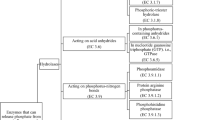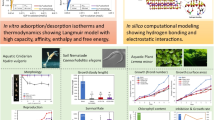Abstract
Enzymes released extracellularly by micro-organisms have major functions in nutrient acquisition and organic matter degradation. Clay particles, common in many surface waters, can modify enzyme activity. Clay minerals are known to form aggregates with organic molecules, and the formation of enzyme-clay complexes could alter the level of activity. Montmorillonite clay and clay extracted from Elledge Lake (Tuscaloosa, Alabama) basin soil were combined with alkaline phosphatase, glucosidase, protease, and xylosidase solutions to assess adsorption and the effect of this adsorption on enzyme activity. Adsorption to Elledge Lake basin clay decreased alkaline phosphatase activity, and adsorption to montmorillonite was observed for all four enzymes with reductions in enzyme activities. Adsorption of substrate onto clay surfaces resulted in a concentration effect and increased enzyme activity associated with the particles. When enzyme-clay complexes were exposed to natural sunlight there was a decrease in enzyme activity, but this decrease was usually not significantly different from the adsorption only treatment. The formation of enzyme-clay complexes may serve to protect the enzymes from natural in situ photodegradation. The results indicate the complex interactive effects adsorption of enzymes to clay particles can have on the availability and capability of hydrolysis – reduction of enzyme reactivity, storage attached to clay particles with changes in transport and distribution, and protection from photodegradation.
Similar content being viewed by others
References
Arnarson T.S. and Keil R.G. 2000. Mechanisms of pore water organic matter adsorption to montmorillonite. Mar. Chem. 71: 309–320.
Boavida M.-J. and Wetzel R.G. 1998. Inhibition of phosphatase activity by dissolved humic substances and hydrolytic reactivation by natural ultraviolet light. Freshwat. Biol. 40: 285–293.
Cabezas M.J., Salvador D. and Sinisterra J.V. 1991. Stabilization-activation of pancreatic enzymes adsorbed on to a sepiolite clay. J. Chem. Technol. Biotechnol. 52: 265–274.
Cairns-Smith A.G. 1986. Introducing clay. In: Cairns-Smith A.G. and Hartman H. (eds), Clay Minerals and the Origin of Life. Cambridge University Press, New York, USA.
Celis R., Hermosin M.C. and Cornejo J. 2000. Heavy metal adsorption by functionalized clays. Environ. Sci. Technol. 34: 4593–4599.
Chappell K.R. and Goulder R. 1994a. Seasonal variation of epilithic extracellular enzyme activity in three diverse headstreams. Arch. Hydrobiol. 130: 195–214.
Chappell K.R. and Goulder R. 1994b. Seasonal variation of epiphytic extracellular enzyme activity on two freshwater plants. Phragmites australis and Elodea Canadensis. Arch. Hydrobiol. 132: 237–253.
Clapp C.E. and Hayes M.H.B. 1999. Characterization of humic substances isolated from clay-and silt sized fractions of a corn residue-amended agricultural soil. Soil Sci. 164: 899–913.
Garde K. and Gustavson K. 1999. The impact of UV-B radiation on alkaline phosphatase activity in phosphorus-depleted marine ecosystems. J. Exp. Mar. Biol. Chem. 238: 93–105.
Hoppe H.-G. 1993. Use of fluorogenic model substrates for extracellular enzyme activity (EEA) measurement of bacteria. Pages 423–433. In: Kemp P.F., Sherr B.F., Sherr E.B. and Cole J.J. (eds), Handbook of Methods in Aquatic Microbial Ecology. Lewis Publishers, Boca Raton, Florida, USA.
Jones S.E. and Lock M.A. 1989. Hydrolytic extracellular enzyme activity in heterotrophic biofilms from two contrasting streams. Freshwat. Biol. 22: 289–296.
Lünsdorf H., Erb R.W., Abraham W.-R. and Timmis K.N. 2000. ‘Clay hutches’: a novel interaction between bacteria and clay minerals. Environ. Microb. 2: 161–169.
Mallet C. and Debroas D. 2001. Regulation of β-and α-glycolytic activities in the sediments of a eutrophic lake. Microb. Ecol. 41: 106–113.
Matthes W. and Kahr G. 2000. Sorption of organic compounds by Al and Zr-hydroxy-intercalated and pillared bentonite. Clays. Clay Minerals. 48: 593–602.
Meyer-Reil L.-A. 1987. Seasonal and spatial distribution of extracellular enzymatic activities and microbial incorporation of dissolved organic substrates in marine sediments. Appl. Environ. Microbiol. 53: 1748–1755.
Moss B. 1972. The influence of environmental factors on the distribution of freshwater algae: An experimental study. 1. Introduction and the influence of calcium concentration. J. Ecol. 60: 917–932.
Münster U., Einiö P. and Nurminen L.J. 1989. Evaluation of the measurements of extracellular enzyme activities in a polyhumic lake by means of studies with 4–methylumbelliferyl-substrates. Arch. Hydrobiol. 115: 321–337.
Namjesnik-Dejanovic K., Maurice P.A., Aiken G.R., Cabaniss S., Chin Y.-P. and Pullin M.J. 2000. Adsorption and fractionation of a muck fulvic acid on kaolinite and goethite at pH 3.7, 6, and 8. Soil. Sci. 165: 545–559.
Quiquampoix H., Stauton S., Baron M.-H. and Ratcliffe R.G. 1993. Interpretation of the pH dependence of protein adsorption on clay mineral surfaces and its relevance to the understanding of extracellular enzyme activity in soil. Colloids Surfaces A: Physicochem. Eng. Aspects 75: 85–93.
Rao M.A. and Gianfreda L. 2000. Properties of acid phosphatasetannic acid complexes formed in the presence of Fe and Mn. Soil. Biol. Biochem. 32: 1921–1926.
Romaní A.M. and Sabater S. 1999. Epilithic ectoenzyme activity in a nutrient-rich Mediterranean river. Aquat. Sci. 61: 122–132.
Romaní A.M. and Sabater S. 2000. Influence of algal biomass on extracellular enzyme activity in river biofilms. Microb. Ecol. 41: 16–24.
Sala M.M., Karner M., Arin L. and Marrase C. 2001. Measurement of ectoenzyme activities as an indication of inorganic nutrient imbalance in microbial communities. Aquat. Microb. Ecol. 23: 301–311.
Smith R.E.H., Furgal J.A., Charlton M.N., Greenberg B.M., Hiriart V. and Marwood C. 1999. Attenuation of ultraviolet radiation in a large lake with low dissolved organic matter concentrations. Can. J. Fish. Aquat. Sci. 56: 1351–1361.
Tietjen T.E. and Wetzel R.G. 2003. Seasonal and spatial distribution of bacterial biomass and the percentage of viable cells in a reservoir of Alabama. J. Plankton Res. (in press)
Vrba J. 1992. Seasonal extracellular enzyme activities in decomposition of polymer organic matter in a reservoir. Arch. Hydrobiol. Beih. Ergebn. Limnol. 37: 33–42.
Wetzel R.G. 1991. Extracellular enzymatic interactions in aquatic ecosystems: Storage, redistribution, and interspecific communication. In: Chróst R.J. (ed.), Microbial Enzymes in Aquatic Environments. Springer-Verlag, New York, New York, USA, pp. 6–28.
Author information
Authors and Affiliations
Corresponding author
Rights and permissions
About this article
Cite this article
Tietjen, T., Wetzel, R.G. Extracellular enzyme-clay mineral complexes: Enzyme adsorption, alteration of enzyme activity, and protection from photodegradation. Aquatic Ecology 37, 331–339 (2003). https://doi.org/10.1023/B:AECO.0000007044.52801.6b
Issue Date:
DOI: https://doi.org/10.1023/B:AECO.0000007044.52801.6b




